Large format lenses from VEB Carl Zeiss Jena 1945 ... - Lens-Club
Large format lenses from VEB Carl Zeiss Jena 1945 ... - Lens-Club
Large format lenses from VEB Carl Zeiss Jena 1945 ... - Lens-Club
Create successful ePaper yourself
Turn your PDF publications into a flip-book with our unique Google optimized e-Paper software.
<strong>Large</strong> <strong>format</strong> <strong>lenses</strong> <strong>from</strong> <strong>VEB</strong> <strong>Carl</strong> <strong>Zeiss</strong> <strong>Jena</strong> <strong>1945</strong> - 1991<br />
© 2003-2012 Arne Cröll – All Rights Reserved (this version is <strong>from</strong> November 17, 2012 – the first version<br />
of this article appeared in “View Camera” July/August 2003).<br />
Many large <strong>format</strong> photographers own a few <strong>lenses</strong> they bought used, either to save money or because<br />
specific features are no longer available in new production <strong>lenses</strong>. Until 1989, most <strong>lenses</strong> came <strong>from</strong><br />
West Germany, Japan, or the USA. Obviously, there were view cameras and large <strong>format</strong> (LF) <strong>lenses</strong><br />
in the Eastern Bloc countries during the Cold War, but not much was known about them. This<br />
changed since the Berlin wall came down, and many of these <strong>lenses</strong> have now found their way into the<br />
global used market. The largest manufacturer behind the iron curtain was <strong>Carl</strong> <strong>Zeiss</strong> <strong>Jena</strong> in the German<br />
Democratic Republic (GDR) as the direct successor of the well-known prewar company of the<br />
same name. Other Eastern Bloc LF lens manufacturers included Meyer-Optik (formerly Hugo Meyer<br />
Görlitz, also in the GDR), Meopta in the Czech Republic, PZO in Poland, and several companies such<br />
as LOMO, KOMZ, and KMZ in the Soviet Union (see the other article on Eastern Bloc <strong>lenses</strong>:<br />
http://www.arnecroell.com/eastern-bloc-new.pdf).<br />
<strong>VEB</strong> <strong>Carl</strong> <strong>Zeiss</strong> <strong>Jena</strong><br />
At the end of World War II the German state of Thuringia, where <strong>Jena</strong> is located, was under the control<br />
of British and American troops. However, the Yalta Conference agreement placed it under Soviet<br />
control shortly thereafter. Just before the US command handed the administration of Thuringia over<br />
to the Soviet Army, American troops moved a considerable part of the leading management and research<br />
staff of <strong>Carl</strong> <strong>Zeiss</strong> <strong>Jena</strong> and of the Schott glass company to Heidenheim near Stuttgart, 126<br />
people in all. This led to the foundation of “Opton Optische Werke” in Oberkochen West Germany,<br />
initially as subsidiary of <strong>Carl</strong> <strong>Zeiss</strong> <strong>Jena</strong>. The latter, however, was nationalized in 1948 by the communist<br />
rulers of the GDR as “<strong>VEB</strong> <strong>Carl</strong> <strong>Zeiss</strong> <strong>Jena</strong>” and later became one of the big industrial “combines”<br />
of the GDR (“<strong>VEB</strong>” is a GDR acronym for a nationalized company, standing for “Volkseigener<br />
Betrieb”). The nationalization and the Cold War subsequently led to the separation of <strong>Zeiss</strong> into a new<br />
independent establishment in Oberkochen (changing its name <strong>from</strong> Opton to <strong>Zeiss</strong>-Opton back to<br />
<strong>Carl</strong> <strong>Zeiss</strong> over a few years), and the traditional company location in <strong>Jena</strong> in the GDR.<br />
Operations at <strong>Carl</strong> <strong>Zeiss</strong> <strong>Jena</strong> were initially hampered by war damage, the removal of key personnel<br />
to the American sector, and later also to Russia, as well as the subsequent dismantling of<br />
equipment by the Soviet army, leaving only 6% of the production equipment. Nevertheless, <strong>Carl</strong> <strong>Zeiss</strong><br />
<strong>Jena</strong> resumed production shortly after the war and became the major supplier of optical equipment in<br />
the Eastern Bloc countries during the cold war. Over the years, the GDR concentrated their optical,<br />
precision machining, and electronic industry under the roof of the <strong>VEB</strong> <strong>Carl</strong> <strong>Zeiss</strong> <strong>Jena</strong>. This also included<br />
the assimilation of the other well-known GDR manufacturer of photographic <strong>lenses</strong>, Meyer-<br />
Optik, through the integration of the camera manufacturer <strong>VEB</strong> Pentacon in 1985. In 1989, <strong>VEB</strong> <strong>Carl</strong><br />
<strong>Zeiss</strong> <strong>Jena</strong> was one of the biggest GDR companies with 69,000 employees. A vast range of products in<br />
1
the fields of optics and precision machinery was produced, <strong>from</strong> binoculars to planetariums to microelectronics.<br />
The postwar separation of <strong>Zeiss</strong> also lead to two distinctively different large <strong>format</strong> lens lines.<br />
<strong>Zeiss</strong> Oberkochen developed a completely new line of Biogon, Planar, Sonnar, and Tessar <strong>lenses</strong> for<br />
Linhof press and technical cameras, to be used at wide apertures for the 6x9cm and 4x5” <strong>format</strong>s.<br />
These were discontinued around 1972, and subsequently <strong>Zeiss</strong> Oberkochen left the large <strong>format</strong> field<br />
except for a few special orders. <strong>Carl</strong> <strong>Zeiss</strong> <strong>Jena</strong> initially continued some of the pre-war lens lines for<br />
large <strong>format</strong> and process cameras, and later phased in replacements and new developments.<br />
Actually, most or all of the <strong>Carl</strong> <strong>Zeiss</strong> <strong>Jena</strong> <strong>lenses</strong> were not manufactured in <strong>Jena</strong> proper, but at<br />
another <strong>Zeiss</strong> plant in Saalfeld, Thuringia, about 30 miles <strong>from</strong> <strong>Jena</strong>. The Saalfeld plant has its own<br />
history. It was originally founded in 1910/1911 as Optische Anstalt Saalfeld (OAS) by <strong>Carl</strong> <strong>Zeiss</strong> <strong>Jena</strong>,<br />
the company Winkel <strong>from</strong> Göttingen, and Alfred Gruchot, a former manager of Hugo Meyer Görlitz.<br />
Initially, OAS produced optical parts and low- to medium-priced objectives for camera manufacturers<br />
like Contessa-Nettel and Franke & Heidecke (Rollei). After the famous merger of Contessa-Nettel,<br />
Ernemann, Goerz, and ICA in 1926 to form <strong>Zeiss</strong>-Ikon, that company became OAS’ main customer.<br />
After WWII, OAS was integrated into the <strong>VEB</strong> <strong>Carl</strong> <strong>Zeiss</strong> <strong>Jena</strong>, where they made most photographic,<br />
movie, video, projection, and process <strong>lenses</strong> for <strong>Zeiss</strong>, as well as other components. In 1985, there<br />
were plans to move the GDR production of photographic <strong>lenses</strong> <strong>from</strong> Saalfeld to the Görlitz plant of<br />
<strong>VEB</strong> Pentacon/Meyer-Optik, but this was never realized.<br />
Four years later, in 1989, the Berlin wall came down and in October 1990 Germany was reunited.<br />
Following the reunification, the nationalized companies of the GDR (about 8000) were taken over<br />
by a government trust agency called “Treuhand”, to be turned over to new management through privatization<br />
or to be closed down. This included <strong>Carl</strong> <strong>Zeiss</strong> <strong>Jena</strong> and its Saalfeld plant. <strong>Carl</strong> <strong>Zeiss</strong> Oberkochen<br />
took back only a core part, including microscopy, astronomical, and geodetic instruments, but<br />
not photographic optics. Another part of <strong>Zeiss</strong> <strong>Jena</strong> formed the new company Jenoptik, now successfully<br />
working in clean room technology, photonics, and other fields. The Saalfeld plant continued operations<br />
under the Treuhand trustee management until they were sold to Docter Optic in August<br />
1991. The last large <strong>format</strong> <strong>lenses</strong> produced before Docter Optic took over were a batch of 300mm<br />
f/4.5 Tessars made in June 1991. The Docter Optic era is the topic of a separate article and includes<br />
my experiences with some of their <strong>lenses</strong> (http://www.arnecroell.com/docter.pdf).<br />
LF <strong>lenses</strong> <strong>from</strong> <strong>Carl</strong> <strong>Zeiss</strong> <strong>Jena</strong><br />
An important difference compared to Western production was that the majority of the <strong>Carl</strong> <strong>Zeiss</strong> <strong>Jena</strong><br />
LF <strong>lenses</strong> came in barrel mounts. The GDR produced between the lens shutters, but mostly in the 00<br />
size for 35mm or medium <strong>format</strong> folding cameras. Shutter names were “Tempor” (<strong>VEB</strong> <strong>Zeiss</strong> Ikon<br />
Dresden), “Junior” (Werner/Fotoverschlüsse Tharandt), “Priomat”, and “Prestor” (<strong>VEB</strong> KKWD/<strong>VEB</strong><br />
Pentacon Dresden), but not many were made for LF <strong>lenses</strong>. Prestors 1, 3, and 5 were produced only<br />
<strong>from</strong> 1964-1966; note that these Prestors were a different construction than the better known highspeed<br />
Prestor in 00 size made by <strong>VEB</strong> <strong>Zeiss</strong> Ikon since 1958. <strong>Zeiss</strong> <strong>Jena</strong> also used West-German<br />
Compound and Compur shutters for Tessars in the fifties, probably for selling them on Western markets.<br />
The production numbers of the shuttered Tessars are listed in table 2a. Many <strong>Zeiss</strong> LF <strong>lenses</strong><br />
2
were originally used with a shutter behind the lens in the cameras of the Pentacon “Mentor” lines, or<br />
in the “Globica“, a traditional tailboard camera on a stand. For instance, between 1946 and 1991 <strong>Carl</strong><br />
<strong>Zeiss</strong> <strong>Jena</strong> produced over 21,000 units of the f/4.5 210mm Tessar (their LF lens with the highest production<br />
number) in various barrel mounts, but only 1,737 <strong>lenses</strong> of the same type in a shutter. Note<br />
that the barrel <strong>lenses</strong> can usually not be put into a shutter without some machining. Some of them, like<br />
the Apo-Germinar W, actually have the individual <strong>lenses</strong> mounted directly into the barrel, not with<br />
assembled front and back lens cells that screw into a separate barrel mount with aperture. In others,<br />
like some of the Apo-Tessars, the lens cells unscrew easily <strong>from</strong> the mount. Nevertheless, <strong>lenses</strong> <strong>from</strong><br />
<strong>Carl</strong> <strong>Zeiss</strong> <strong>Jena</strong> are usually of very high quality and therefore the cost for having them mounted in a<br />
shutter or in front of one can sometimes be justified. In addition, they can be used without major modifications<br />
on cameras with a shutter behind the lens, such as a Sinar or Packard shutter. Most barrel<br />
mounts have the classic nonlinear aperture scale with a nearly round diaphragm opening. Apo-<br />
Germinar models (at least after 1970) have a linearized scale.<br />
The manufacturers name engraved on the lens might be “<strong>Carl</strong> <strong>Zeiss</strong> <strong>Jena</strong>”, “<strong>Carl</strong> <strong>Zeiss</strong> <strong>Jena</strong><br />
DDR”, “CZJ”, “Jenoptik”, “Aus <strong>Jena</strong>”, “Ernst Abbe <strong>Jena</strong>”, or simply “<strong>Jena</strong>”, depending on when and<br />
where the lens was sold. These differences result <strong>from</strong> the long and convoluted legal struggles on the<br />
use of the <strong>Zeiss</strong> name between <strong>Zeiss</strong> Oberkochen and <strong>Zeiss</strong> <strong>Jena</strong> during the Cold War. Conversely,<br />
<strong>Carl</strong> <strong>Zeiss</strong> Oberkochen had to use the name “Opton” in the Eastern Bloc countries. There was also a<br />
small series of <strong>lenses</strong> labeled “Meyer-Optik” that were Tessars made by CZJ for Meyer in 1991 for a<br />
mahogany version of the Globica – it has the serial number of the last lot under the <strong>Carl</strong> <strong>Zeiss</strong> <strong>Jena</strong> era<br />
and the mount is the same. There is no lens name (neither “Tessar” nor “Trioplan” - Meyers old triplet<br />
name) engraved. Whether this was an exception because of the turbulent economic situation after the<br />
reunification, or if there was previous production by <strong>Zeiss</strong> <strong>Jena</strong> for other companies as an OEM supplier<br />
is unknown.<br />
<strong>Carl</strong> <strong>Zeiss</strong> <strong>Jena</strong> serial numbers followed the prewar numbering scheme until 1980, when they<br />
changed to a new system. The old system, with up to 8 digits (highest number 11,036,647), was only<br />
approximately chronological, and semicontinuous across lens types. Once an internal order for a lot of<br />
<strong>lenses</strong> was issued, a continuous block of numbers was assigned to this order, even though the production<br />
might have taken considerable time, sometimes years. Occasionally not all numbers assigned were<br />
used, in which case these numbers were reused and assigned to a different lot or some prototype production.<br />
Unless one has the numbers <strong>from</strong> the original production files, the number range given in<br />
table 1 allows only a rough estimate of production time, with an error of ±2 years, occasionally more.<br />
In 1980 the system changed completely. Each specific lens type had its own number series with 4 - 5<br />
digits, always starting at 1001. Thus different <strong>lenses</strong> can have the same serial no. and will also duplicate<br />
very early <strong>Zeiss</strong> production numbers. Errors occurred occasionally with the new system and sometimes<br />
the same serial no. block was issued to the same lens type twice. Without the production files, no easy<br />
dating of <strong>lenses</strong> is possible within the new system, but it was only in effect for 12 years (1980-1991).<br />
All post-war <strong>Carl</strong> <strong>Zeiss</strong> <strong>Jena</strong> LF <strong>lenses</strong> were coated, with the possible exception of early postwar<br />
<strong>lenses</strong>. Initially the red “T” designation was used for coated <strong>lenses</strong>, but dropped later when coating<br />
became standard procedure. <strong>Zeiss</strong> <strong>Jena</strong> introduced multicoating in 1976, 4 years after <strong>Zeiss</strong> Ober-<br />
3
kochen, but mostly for 35mm and medium <strong>format</strong> <strong>lenses</strong>. To my knowledge, the only <strong>Zeiss</strong> <strong>Jena</strong> LF<br />
<strong>lenses</strong> with multicoating are the Apo-Germinar W <strong>lenses</strong>.<br />
A note on the tables: The <strong>Zeiss</strong> production files indicate that lens design parameters were<br />
changed occasionally for a lens of a given name, as listed in tables 2b, 3b, and 4b, to adjust for different<br />
glasses available, or to improve the performance. The mounts and mount materials (brass vs. aluminum)<br />
also changed over 45 years, so weights and filter dimensions can vary. The mounts of the most<br />
recent <strong>lenses</strong> will most likely be identical to the Docter Optic counterparts described in the Docter<br />
article. Image circles were calculated <strong>from</strong> the coverage angle; for the Tessars (table 2a) and the specialty<br />
<strong>lenses</strong> (table 6), the image circle is given for infinity. For the process <strong>lenses</strong> (tables 3a, 4a, 5) it is<br />
given for 1:1. At infinity, the image circle is about half that value.<br />
Tessar <strong>lenses</strong><br />
The standard LF <strong>lenses</strong> made by <strong>Carl</strong> <strong>Zeiss</strong> <strong>Jena</strong> were Tessars. These are direct descendants of Paul<br />
Rudolph’s original Tessar <strong>from</strong> 1902, with 4 lens elements in 3 groups. Tables 2a and b lists only<br />
Tessars <strong>from</strong> 135mm up, since anything shorter won’t cover 4x5”, but there were of course shorter<br />
focal lengths available. Tessars were also used and sold as enlarging <strong>lenses</strong>. Initially, three series existed<br />
after WWII, with maximum openings of f/3.5, f/4.5, and f/6.3, respectively. The f/3.5 Tessars, a 2 nd<br />
generation designed by Willy Merté and Ernst Wandersleb before WWII, were discontinued in the<br />
mid-1950’s. The two f/6.3 Tessars were discontinued in the late 1960’s; both were new designs (1947)<br />
and differed <strong>from</strong> Wandersleb’s 1911 versions with the same specification. Only the f/4.5 series was<br />
continued to the very end in 1991. A variety of designs existed for the f/4.5 series; the shorter focal<br />
lengths used mostly postwar designs, but the longer ones used the late 1920’s designs (probably also by<br />
Merté) to the very end.<br />
The optimum aperture for the Tessars is f/22. The f/3.5 and f/4.5 versions can do double duty,<br />
as portrait <strong>lenses</strong> wide open, and stopped down to the optimum aperture for technical subjects, architecture<br />
etc. The f/3.5 version shows some visible focus shift, so for best results it is advisable to focus<br />
at the taking aperture <strong>from</strong> wide open down to f/5.6, whereas f/8 should be for focusing used when<br />
stopped down more. If this is taken into account, even the older Tessars can deliver high quality results.<br />
Process <strong>lenses</strong>: Apo-Tessar<br />
The other <strong>lenses</strong> used for large <strong>format</strong> are the process <strong>lenses</strong> made by <strong>Carl</strong> <strong>Zeiss</strong> <strong>Jena</strong>. They first produced<br />
Apo-Tessars, similar to what they had prior to WWII (tables 3a and b). As process <strong>lenses</strong>, they<br />
are optimized for a 1:1 reproduction ratio, but can be used at infinity. Apo-Tessars were originally built<br />
like regular Tessars (4 elements/3 groups), but used a special glass (a short flint, “KF” in the Schott<br />
nomenclature) with abnormal dispersion. They are optimized for high definition over a smaller field<br />
than regular Tessars. Thus they have less coverage (43°), and a maximum opening of f/9 or less. The<br />
coverage may be higher for less stringent requirements in pictorial use. Optimum aperture is again<br />
f/22. Initially, these were based on designs <strong>from</strong> the late 1920’s, although the 140mm and 180mm versions<br />
got redesigned in 1939. Those <strong>lenses</strong> are still marked in cm instead of mm, despite post-war production<br />
dates and coating. In 1955, CZJ redesigned them again, introducing a small air gap in the back<br />
4
cell instead of the cemented interface, so the latest design is a 4/4 construction. Most of those versions<br />
carry the focal length in mm.<br />
Process <strong>lenses</strong>: Apo-Germinar<br />
Subsequently, the Apo-Tessars were replaced with the newly developed Apo-Germinars (tables 4a and<br />
b), originally designed by Harry Zöllner, the head of the <strong>Zeiss</strong> <strong>Jena</strong> design office <strong>from</strong> 1946 to 1977.<br />
There was some overlap in production as the last Apo-Tessars where produced up to the late 1960’s,<br />
and Apo-Germinars were introduced in the early 1960’s. Later, Apo-Germinars went through one or<br />
two redesigns, depending on the type. The original design version <strong>from</strong> 1957 used 6 <strong>lenses</strong> in 6 groups<br />
for all focal lengths, but the redesign <strong>from</strong> 1962 switched to a classic process lens design of the Dialyte<br />
type, 4 elements in 4 groups for focal lengths up to 450mm. Only a few hundred <strong>lenses</strong> of the original<br />
6-element design have been produced for each focal length. The longer focal lengths retained 6 elements<br />
in 6 groups, i.e. the 600, 750, 900, 1000mm, and 1200mm versions. The Apo-Germinars have<br />
46° coverage, with a maximum opening of f/9, similar to Apo-Artars or Apo-Ronars. They are all optimized<br />
for a 1:1 reproduction ratio, but it is well known that this lens type holds up quite well when<br />
used at infinity. The optimum aperture of the Apo-Germinars is f/22. For the later 6/6 version a patent<br />
was granted in 1964 (in West-Germany; 1965 in Britain). Apo-Germinars are very high quality <strong>lenses</strong><br />
and offer exceptional performance. They are at least as good as their Apo-Ronar, Apo-Artar, or Apo-<br />
Nikkor counterparts and were sold on Western markets at a premium price. For comparison, in the<br />
long focal lengths Rodenstock offered similar 6- or 8-element Apo-Ronars (in addition to their regular<br />
4-element ones of the same focal lengths) as their ultimate process <strong>lenses</strong> for the most demanding applications.<br />
Process <strong>lenses</strong>: Apo-Germinar W<br />
The latest development was the introduction of the Apo-Germinar W series in 1981, symmetric wideangle<br />
process <strong>lenses</strong> with 63-73° coverage (table 5). The design is rather unique and expensive to manufacture<br />
with 8 elements in 8 groups ( - + - + I + - + - ). Other process <strong>lenses</strong> with similar coverage<br />
either use a 6/4 Plasmat construction (Rodenstock Apo-Gerogon, Schneider G-Claron, Fujinon-A) or a<br />
4/4 double Gauss meniscus construction of the Topogon type (Process Nikkors, Schneider G-Claron<br />
WA). The optimum aperture for the Apo-Germinar W is f/16, 1 stop faster than the <strong>lenses</strong> of most<br />
competitors. These <strong>lenses</strong> are multicoated, probably because of the 16 glass-air surfaces involved, but<br />
are not marked MC or otherwise. <strong>Zeiss</strong> <strong>Jena</strong> claimed a superior performance of the Apo-Germinar W<br />
compared to standard wide angle process <strong>lenses</strong>, and they indeed have a remarkably high and even<br />
modulation transfer function over the field. The price for the high performance is a rather large size<br />
and weight in relation to their focal length and coverage. Apo-Germinar W <strong>lenses</strong> were available with<br />
individual center filters to counter any illumination falloff. The 210mm and 240mm versions make<br />
great enlarging <strong>lenses</strong> for 8x10”, and the 150mm for 4x5”.<br />
Other <strong>lenses</strong><br />
In addition to the <strong>lenses</strong> described above, <strong>Carl</strong> <strong>Zeiss</strong> <strong>Jena</strong> produced small prototype batches of LF<br />
<strong>lenses</strong> that never found their way into full production, like the ones for the “Grandina” camera<br />
5
planned by Meopta (see http://www.arnecroell.com/grandina.pdf) and other longer focal lengths Biometars.<br />
They also made <strong>lenses</strong> for aerial reconnaissance and photogrammetry like the Lamegon, Superlamegon,<br />
Lametar, and Pinatar <strong>lenses</strong>, and <strong>lenses</strong> for other uses that may be used as large <strong>format</strong><br />
optics. They are listed in table 6.<br />
Acknowledgements<br />
Many thanks go to Joerg Krusche for his help and lots of valuable in<strong>format</strong>ion, to my wife Shari Feth<br />
for editing and suggesting corrections and for putting up with my lens obsession, to Dan Fromm for<br />
additional in<strong>format</strong>ion, and to Kerry Thalmann for his initial encouragement to write this article series.<br />
References<br />
I’ve drawn on printed sources as well as internet postings. A major help was a book based on a set of<br />
<strong>Zeiss</strong> file cards, listing the manufacturing dates and numbers of nearly all <strong>Zeiss</strong> <strong>Jena</strong> <strong>lenses</strong> <strong>from</strong> 1927<br />
to 1991:<br />
Thiele, Hartmut: Fabrikationsbuch Photooptik – <strong>Carl</strong> <strong>Zeiss</strong> <strong>Jena</strong>. Private printing, 6th Ed., Munich<br />
2009.<br />
Other printed sources were:<br />
German and English <strong>Carl</strong> <strong>Zeiss</strong> <strong>Jena</strong> brochures on the Apo-Germinars (1974, 1982, 1984) and the barrel<br />
Tessars (1969).<br />
Thiele, Hartmut: Die deutsche Photoindustrie – wer war wer. Private printing, 2nd Ed., Munich 2002.<br />
Thiele, Hartmut: 150 Jahre Photooptik in Deutschland 1849-1999. Private printing, 4th Ed., Munich<br />
2002.<br />
Thiele, Hartmut: <strong>Carl</strong> <strong>Zeiss</strong> <strong>Jena</strong> – Entwicklung und Beschreibung der Photoobjektive und ihre erfinder.<br />
Private Printing, 2nd. Ed. Munich 2007<br />
Wright, A.N. and Matthews, D.: A <strong>Lens</strong> Collectors Vade Mecum. 2nd Ed., Redruth, Cornwall 1998<br />
(pdf on CD)<br />
Hermann, Armin: Und trotzdem Brüder- die deutsch-deutsche Geschichte der Firma <strong>Carl</strong> <strong>Zeiss</strong>. Piper,<br />
Munich 2002, ISBN 3-492-23821-1<br />
Markowski, Frank (Ed.): Der letzte Schliff – 150 Jahre Arbeit und Alltag bei <strong>Carl</strong> <strong>Zeiss</strong>. Aufbau Verlag,<br />
Berlin 1997, ISBN 978-3-351024-58-1<br />
Jehmlich, Gerhard: Der <strong>VEB</strong> Pentacon Dresden. Sandstein Verlag, Dresden 2009. ISBN 978-3-<br />
940319-75-3<br />
6
Arne Cröll has been involved in large <strong>format</strong> photography since 1991. His primary photographic interests are<br />
landscape and still life, mostly in black and white. His preferred <strong>format</strong> is 4x5”, but he also uses 8x10”. Being<br />
a materials scientist by profession, he enjoys the combination of the creative and technical aspects of large<br />
<strong>format</strong> photography. His interest in <strong>Carl</strong> <strong>Zeiss</strong> <strong>Jena</strong> and Docter Optic goes back to 1994, when he visited the<br />
Docter Optic booth at Photokina. Presently, he shares his time between Freiburg in Germany anf Huntsville,<br />
AL, USA. He can be reached at acroell@knology.net, his web site is http://www.arnecroell.com.<br />
Table 1. Approximate <strong>VEB</strong> <strong>Carl</strong> <strong>Zeiss</strong> <strong>Jena</strong> serial number range for the old number system through 1980. See<br />
text for details.<br />
Year Serial Number<br />
1947 3,000,000<br />
1951 3,500,000<br />
1954 4,000,000<br />
1957 5,000,000<br />
1960 6,000,000<br />
1965 7,000,000<br />
1968 8,000,000<br />
1972 9,000,000<br />
1976 10,000,000<br />
1980 11,000,000<br />
7
Table 2a. <strong>VEB</strong> <strong>Carl</strong> <strong>Zeiss</strong> <strong>Jena</strong> Tessars. Different weights for the same lens are <strong>from</strong> different sources and are<br />
caused by the change in mount materials over time. The 60° angle and the image circle numbers in {} for the<br />
f/4.5 Tessars are <strong>from</strong> a 1969 <strong>Zeiss</strong> brochure, the other values <strong>from</strong> later sources.<br />
Focal<br />
Length<br />
[mm]<br />
Max.<br />
Aperture<br />
Angle of<br />
Coverage<br />
[°]<br />
Image Circle<br />
(calculated)<br />
[mm]<br />
Mount/<br />
Shutter<br />
8<br />
Filter<br />
Size<br />
Weight<br />
[g/oz.]<br />
Remarks<br />
150 3.5 57 163<br />
Compur 2<br />
barrel M49x0.75 270/9.5<br />
50 produced<br />
155 produced<br />
165 3.5 57 179<br />
Compound III<br />
barrel<br />
50 produced<br />
1375 produced<br />
210 3.5 57 228<br />
Compound IV<br />
barrel M67x0.75 660/23.3<br />
75 produced<br />
2200 produced<br />
250 3.5 57 271<br />
Compound V<br />
barrel<br />
M84x1<br />
M84x1<br />
1252/44.2<br />
920/32.5<br />
45 produced<br />
665 produced<br />
300 3.5 57 326 barrel 305 produced<br />
135 4.5 57/60 147 {160}<br />
Compur 1<br />
barrel<br />
M40.5x0.5<br />
M40.5x0.5<br />
257/9.1<br />
105/3.7<br />
300 produced<br />
11016 produced<br />
150 4.5 55/60 156 {180}<br />
Compur 1<br />
barrel<br />
M40.5x0.5<br />
M49x0.75<br />
210/7.4<br />
220/7.8<br />
1750 produced<br />
972 produced<br />
165 4.5 55/60 172 {200} barrel M58x0.75 280/9.9 690 produced<br />
Compur 2 M49x0.75 343/12.1 330 produced<br />
180 4.5 55/60 187 {220}<br />
Compound III<br />
barrel M58x0.75<br />
390/13.8<br />
215/7.6<br />
25 produced<br />
18512 produced<br />
Compound III 1637 produced<br />
210 4.5 55/60 219 {250}<br />
Prestor 3 M58x0.75 521/18.4<br />
100 produced (in<br />
1968)<br />
barrel M67x0.75<br />
490/17.3<br />
335/11.8<br />
21664 produced<br />
Compound IV 325 produced<br />
250 4.5 55/60 260 {300}<br />
barrel M77x0.75<br />
690/24.3<br />
500/17.6<br />
15696 produced<br />
300 4.5 55/60 312 {360}<br />
Compound V<br />
Prestor 5<br />
barrel<br />
M84?<br />
M95x1<br />
1176/41.5<br />
1188/41.9<br />
1270/44.8<br />
1005/35.5<br />
488 produced<br />
11270 produced<br />
360 4.5 55/60 375 {430} barrel M105x1<br />
1870/66<br />
1550/54.7<br />
3525 produced<br />
135 6.3 70 189<br />
Compur 0<br />
barrel M35.5x0.5 110/3.9<br />
250 produced<br />
811 produced<br />
165 6.3 barrel 800 produced<br />
Compur 1 M40.5x0.5 195/6.9 125 produced<br />
210 6.3 70 294 Prestor 1<br />
25 produced (in<br />
1965)<br />
barrel M40.5x0.5 110/3.9 3272 produced
Table 2b. <strong>VEB</strong> <strong>Carl</strong> <strong>Zeiss</strong> <strong>Jena</strong> Tessar design dates and serial numbers.<br />
Focal Length<br />
[mm]<br />
Max.<br />
Aperture<br />
Design<br />
Year<br />
10<br />
Serial Numbers<br />
150 3.5<br />
1926<br />
1952<br />
3,605,301-3,605,400<br />
4,009,801-4,009,900<br />
3,746,023-3,746024<br />
3,746029 – 3,746,030<br />
165 3.5 1926 3,075,001 and higher<br />
210 3.5 1929 3,072,101 and higher<br />
250 3.5 1935 2,731,551 and higher<br />
300 3.5<br />
1937<br />
1953<br />
2,770,035 and higher except<br />
3,746,102-3,746,103<br />
1927<br />
2,850,601-2,850,700<br />
2,868,901-2,869,900<br />
135 4.5<br />
1948<br />
1952<br />
Between 3,072,001 and 4,869,260 except<br />
3,746,058-3,746,059<br />
1957<br />
4,870,946 and higher<br />
1001-1637 (1980-1986)<br />
1947 Between 3,179,494 and 3,669,701 except<br />
1911 3,406,151 – 3,406,600 and<br />
150 4.5 1951 3,623,051-3,623,550<br />
1928 3,873,201 and higher except<br />
1926 3,893,951 – 3,894,000<br />
1911<br />
2,732,001-2,732100<br />
2,743,501-2,743,600<br />
165 4.5<br />
1959<br />
1,001-1,145 (1980-1984) and<br />
5,909,201 and higher except<br />
1926 8,272,129 - 8,272,228<br />
2,814,301-2,814,500<br />
180 4.5<br />
1929<br />
3,778,601-11,022,432<br />
1,001-11,650 (1980-1991)<br />
1948 3,017,685-3,624,900<br />
210 4.5<br />
1929<br />
2,814,501-10,833,987<br />
1,001-7,417; 7,818-8,063 (1981-1991)<br />
1975 7,418-7,817 (1990)<br />
250 4.5 1928 2,789,151 and higher<br />
2,773,566 - 3,181,297<br />
300 4.5<br />
1928<br />
3,791,601-10,832,987<br />
1001-4100 (1981-1991)<br />
1948 3,408,501-3,606,700<br />
360 4.5 1928 2,798,001 and higher; 1001-1800 (1981-1985)<br />
135 6.3<br />
1911<br />
1947<br />
2,920,899<br />
3,087,701 and higher<br />
165 6.3 1911 2,731,601 - 2,938,550<br />
210 6.3<br />
1911<br />
1947<br />
2,919,628-2,920,350<br />
3,071,701 and higher
Table 3a. <strong>VEB</strong> <strong>Carl</strong> <strong>Zeiss</strong> <strong>Jena</strong> Apo-Tessars. Note that Apo-Tessar mounts often have no filter threads, or<br />
uncommon ones.<br />
Focal<br />
Length<br />
[mm]<br />
Max.<br />
Aperture<br />
Angle of<br />
Coverage<br />
Image Circle @<br />
1:1 and f/22<br />
(calculated)<br />
Mount/<br />
Shutter<br />
Weight<br />
[g/oz] Remarks<br />
140 9 43 221 barrel 1031 produced<br />
180 9 43 284 barrel 1010 produced<br />
180 15 30-35 193-227 barrel 560 produced<br />
240 9 43 378 barrel 1073 produced<br />
300 9 43 473 barrel 385/13.6 2395 produced<br />
375 9 43 591 barrel 469 produced<br />
450 9 43 709 barrel 460/16.2 2407 produced<br />
600 9 43 945 barrel 1000/35.3 2296 produced<br />
750 9 43 1182 barrel 1790/63.1 1261 produced<br />
900 9 43 1418 barrel<br />
Only 1 listed in manufacturing<br />
files, more exist<br />
1200 11 43 1890 barrel 70 produced<br />
1800 15 30-35 1929-2270 barrel<br />
Not listed in post-WWII <strong>Zeiss</strong><br />
<strong>Jena</strong> manufacturing files<br />
Table 3b. <strong>VEB</strong> <strong>Carl</strong> <strong>Zeiss</strong> <strong>Jena</strong> Apo-Tessar design dates and serial numbers. The 1955 designs used a small<br />
air gap in the back cell instead of the cemented interface.<br />
Focal Length<br />
[mm]<br />
Max. Aperture<br />
Design<br />
Year<br />
Serial Numbers<br />
140 9<br />
1939<br />
1955<br />
Between 2,907,501 and 3,622,200<br />
3,622,201 and higher<br />
180 9<br />
1939<br />
1955<br />
Between 2,799,101 and 4,435,700<br />
4,676,016 and higher<br />
180 15<br />
1955<br />
1968<br />
7,289,976 – 7,290,000<br />
7,326,281 and higher<br />
Between 2,913,801 and 3,410,770; also 6,360,551-<br />
240 9<br />
1929 6,360,600; 7,047,601 - 7,047,650; 7,258,826 -<br />
7258,850<br />
1955 6,223,701 and higher except the above range<br />
300 9<br />
1927<br />
1955<br />
Between 3,008,101 and 3,411,040<br />
3,411,041 and higher<br />
375 9<br />
1937<br />
1955<br />
Between 3,181,693 and 4,498,834<br />
4,678,126 and higher<br />
450 9<br />
1928<br />
1955<br />
Between 3,016,691 and 4,870,945<br />
4,951,631 and higher<br />
600 9<br />
1928<br />
Between 2,801,161 and 3,608,350; also<br />
4,498,951 - 4,499,050; 4,543,204<br />
1955 4,467,396 and higher except the above range<br />
750 9<br />
1927<br />
1955<br />
Between 2,915,126 and 3,875,870<br />
4,467,431 and higher<br />
900 9 1928 3,608,571; 3,746,098;<br />
1200 11 ? 3,016,941 and higher<br />
11
Table 4a. <strong>VEB</strong> <strong>Carl</strong> <strong>Zeiss</strong> <strong>Jena</strong> Apo-Germinars<br />
Focal<br />
Length<br />
[mm]<br />
Max.<br />
Aperture<br />
<strong>Lens</strong><br />
Elements/<br />
Groups<br />
Angle of<br />
Coverage<br />
Image Circle @<br />
1:1 and f/22<br />
(calculated)<br />
12<br />
Mount/<br />
Shutter<br />
Filter<br />
Size<br />
Weight<br />
[g/oz]<br />
Remarks<br />
140 9.0 6/6 46 232 barrel<br />
- 192/6.8 ca. 140 produced<br />
180 9.0 6/6 46 298 barrel<br />
- 452/15.9 ca. 1140 produced<br />
240 9.0<br />
6/6<br />
and 4/4<br />
46 398 barrel<br />
M49x0.75 300/10.6 1943 produced<br />
300 9.0<br />
6/6<br />
and 4/4<br />
46 497 barrel<br />
M49x0.75 330/11.6<br />
454 produced<br />
360 9.0 4/4 46 596 barrel M67x0.75 780/27.5 1295 produced<br />
375 9.0<br />
6/6<br />
and 4/4<br />
46 621 barrel<br />
1354 produced<br />
450 9.0<br />
6/6<br />
and 4/4<br />
46 746 barrel<br />
M67x0.75 900/31.7 2108 produced<br />
600 9.0 6/6 46 994 barrel M86x1 1890/66.7 1709 produced<br />
750 9.0 6/6 46 1243 barrel M105x1 3480/122.8 633 produced<br />
900 9.0 6/6 46 1491 barrel 96 produced<br />
1000 12.0 6/6 46 1657 barrel M105x1 3800/134 230 produced<br />
1200 11.0 6/6 46 1988 barrel 65 produced<br />
.
Table 4b. <strong>VEB</strong> <strong>Carl</strong> <strong>Zeiss</strong> <strong>Jena</strong> Apo-Germinar design dates and serial numbers<br />
Focal<br />
Length<br />
[mm]<br />
Max.<br />
Aperture<br />
Design<br />
Year<br />
13<br />
Serial Numbers<br />
140 9.0<br />
1957<br />
1962<br />
4,897,126 - 6,259,280<br />
7,208,266 and higher<br />
180 9.0<br />
1957<br />
1962<br />
5,634,668 - 6,259,310; 7,290,101 - 7,290,150<br />
7,208,316 - 7,208,365; 7,333,689 - 7,334,688<br />
1957 Between 4,897,128 and 6,389,424<br />
240 9.0<br />
1962<br />
1970<br />
Between 6,795,606 and 9,000,684<br />
9,228,009 and higher<br />
1;001-2;775 (1981-1989)<br />
1957 Between 4,897,129 and 6,361,320<br />
300 9.0<br />
1962<br />
1970<br />
7,290,226 – 7,290,275<br />
9,228,089 and higher<br />
1,001-1,100 (1982)<br />
360 9.0 1970<br />
9,228,129 and higher<br />
1,001-1,990 (1982-1988)<br />
375 9.0<br />
1957<br />
1962<br />
Between 4,897,130 and 6,798,004<br />
6,798,057 and higher<br />
1955 8,787,771 - 8,787,790<br />
1957 Between 4,897,131 and 7,028,675<br />
450 9.0<br />
1962<br />
1964<br />
Between 8,826,425 and 9,000,764<br />
Between 7,028,676 and 7,355,318<br />
1970<br />
9,228,209 and higher<br />
1,001 – 1,880 (1981-1988)<br />
1956 Between 5,634,741 and 6,389,770<br />
600 9.0<br />
1962<br />
1970<br />
Between 6,504,841 and 9,000,780<br />
9,228,249 and higher<br />
1,001-1,600 (1982-1989)<br />
1957 Between 4,897,132 and 6,621,130<br />
750 9.0<br />
1962<br />
1970<br />
Between 7,131,989 and 8,973,851<br />
9,228,359 and higher<br />
(1,001-1,175) 1985-1988<br />
900 9.0 1957 Between 4,897,133 and 10,405,585<br />
1000 12.0 1970 9,469,721 and higher<br />
1200 11.0 1957 Between 5,634,781 and 7,290,650<br />
Table 5. <strong>VEB</strong> <strong>Carl</strong> <strong>Zeiss</strong> <strong>Jena</strong> Apo-Germinar W <strong>lenses</strong>. The design year was 1981 for all <strong>lenses</strong>, and the production<br />
dates were between 1982 and 1988.<br />
Focal Max.<br />
Length Aper-<br />
[mm] ture<br />
<strong>Lens</strong> Elements/<br />
Groups<br />
Angle of<br />
Coverage<br />
Image Circle @<br />
Mount/<br />
1:1 and f/16<br />
Shutter<br />
(calculated)<br />
Filter<br />
Size<br />
Weight<br />
[g/oz]<br />
Remarks<br />
150 8.0 8/8 63 368 barrel M67x0.75 1030/36.3 850 produced<br />
210 8.0 8/8 68 567 barrel M86x1 1490/52.5 850 produced<br />
240 8.0 8/8 73 710 barrel M110x1 3180/112.2 810 produced
Table 6. <strong>VEB</strong> <strong>Carl</strong> <strong>Zeiss</strong> <strong>Jena</strong> prototype, aerial, and photogrammetry <strong>lenses</strong>. “PI” stands for Pan-Infra, i.e. it<br />
is corrected for both the visible and the near IR spectrum.<br />
<strong>Lens</strong><br />
Name<br />
Focal<br />
Max.<br />
Length<br />
Aperture<br />
[mm]<br />
<strong>Lens</strong> Elements/<br />
Groups<br />
Angle of<br />
Coverage<br />
[°]<br />
Image Circle(calculated)<br />
Mount/<br />
Shutter<br />
Remarks<br />
Biometar 120 2.8 5/4 ? ? barrel<br />
Prototype, around<br />
1979/1980<br />
Biometar 135 4.0 5/4 67<br />
156@f/4<br />
180@f/11<br />
Prestor 1<br />
For Meopta Grandina<br />
camera, 5 produced for<br />
test purposes*<br />
2 produced for test<br />
Biometar 165 2.8 5/4 ? ? ? purposes (designed<br />
1956)<br />
2 produced for test<br />
Biometar 180 2.8 5/4 ? ? ? purposes (designed<br />
1955)<br />
2 produced for test<br />
Biometar 210 4.0 5/4 ? ? ? purposes (designed<br />
1957)<br />
Biometar 210 5.4 5/4 66<br />
240@f/5.4<br />
270@f/16<br />
Prestor 1<br />
For Meopta Grandina<br />
camera, 5 produced for<br />
test purposes*<br />
2 produced for test<br />
Biometar 250 4.0 5/4 ? ? ? purposes (designed<br />
1952)<br />
Dagor 125 9.0 6/2 ? ? ?<br />
26 produced (some for<br />
planetarium use)<br />
Dagor 180 6.8 6/2 ? ? ?<br />
88 produced in special<br />
mount, unknown use<br />
Lamegon 55 5.6 ? ? ?<br />
Electric shutter/Compur<br />
Aerial/Photogrammetry<br />
Lamegon 65 4.5 8/4 105<br />
156@f/4.5<br />
170@f/22<br />
Prestor 1<br />
For Meopta Grandina<br />
camera, 5 produced for<br />
test purposes*<br />
Lamegon 90 4.5 8/4 105<br />
200@f/4.5<br />
224@f/11<br />
Prestor 1<br />
For Meopta Grandina<br />
camera, 5 produced for<br />
test purposes*<br />
Lamegon 100 8 8/4 ? ?<br />
Photogrammetry, for<br />
Electric shutter<br />
UMK 1318<br />
Lamegon 115 4 10/? ? ? ?<br />
Aerial/Photogrammetry,<br />
designed 1962<br />
Lamegon 150 4.5 10/6 ? ?<br />
Aerial for LMK 2323,<br />
designed 1968/74<br />
Lamegon<br />
PI<br />
150 4.5 10/6 91 305 ?<br />
Aerial/Photogrammetry,<br />
designed 1984<br />
Lamegon<br />
PI-D<br />
150 4.0 11/7 91 305 ?<br />
Aerial/Photogrammetry,<br />
designed 1984<br />
Lamegoron 210 5.6 10/6 76 328 ? Aerial/Photogrammetry<br />
14
Lamegor<br />
PI<br />
300 5.6 10/6 56 306 ?<br />
Aerial, for MRB<br />
30/2323, designed 1973<br />
Lamegot 300 5.6 ? 53 ? Aerial/Photogrammetry<br />
Pinatar 115 4 10/6 ? ? ? For RMK<br />
Pinatar 125 4 ? ? ? ?<br />
Photogrammetry, for<br />
MKF-6 (70mm film)<br />
Pinatar 210 4 10/6 69 289 ? Photogrammetry<br />
Super-<br />
Lamegon<br />
PI<br />
64 5.6 12/8 121 230 Electric shutter Photogrammetry/8m<br />
fixed focus<br />
Super-<br />
Lamegon<br />
70 5.6 10/6 ? ? ? Aerial, for MRB 1818<br />
Super-<br />
Lamegon<br />
Super-<br />
90 5.6 11/? 121 318 Electric shutter Aerial, for MRB2323<br />
Lamegon<br />
PI<br />
90 5.6 12/8 121 318 ? ?<br />
Aerial,<br />
Lametar 200 8 6/4 ? ? ? designed 1972,for<br />
UMK1318<br />
Aerial,<br />
Lametar 300 11 4/3 ? ? ? designed 1972/79, Tessar<br />
type, for UMK1318<br />
Tessar 270 8 4/3 53<br />
250@f/8<br />
270@f/16<br />
Prestor 1<br />
For Meopta Grandina<br />
camera, 5 produced for<br />
test purposes*<br />
.<br />
*Very few additional units were produced in the 1970’s in Copal/Copal electric shutters and offered through a photo warehouse<br />
in the USA under the “Aus <strong>Jena</strong>” label.<br />
15
Fig. 1 Tessar 250mm f/3.5 in barrel. Scale length is 10cm/4”.<br />
Fig. 2 Tessars 210mm and 360mm f/4.5 in barrel, late versions. The filter size of the 210mm is 67mm.<br />
Picture courtesy of Jörg Krusche.<br />
16
Fig. 3 Two generations of <strong>Carl</strong> <strong>Zeiss</strong> <strong>Jena</strong> 300mm f/9 process <strong>lenses</strong>. Left: Apo-Tessar (1927 design,<br />
uncoated); Right: Apo-Germinar (1970 design). Scale length is 10cm/4”.<br />
Fig. 4 Two generations of 600mm f/9 process <strong>lenses</strong>. Left: Apo-Tessar (1955 design); Right: Apo-<br />
Germinar 600mm (1970 design). Filter size of the 600mm Apo-Germinar is 86mm. Picture courtesy of<br />
Jörg Krusche.<br />
17
Fig. 5 Apo-Germinar W 210mm f/8 with center filter. Scale length is 10cm/4”.<br />
18




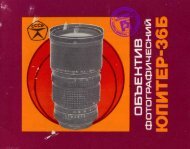


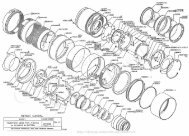


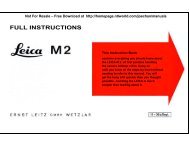
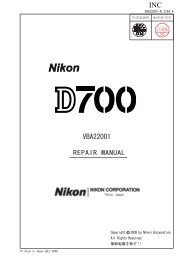
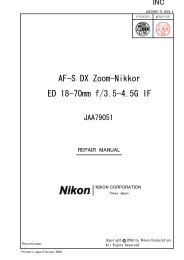
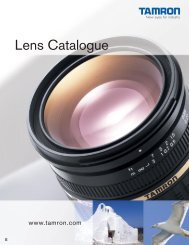

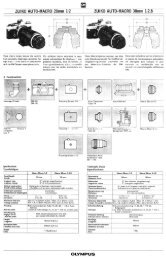

![AF 200 - 400 mm F/5.6 LD [IF] (Model 175D) - Tamron](https://img.yumpu.com/18616610/1/190x245/af-200-400-mm-f-56-ld-if-model-175d-tamron.jpg?quality=85)